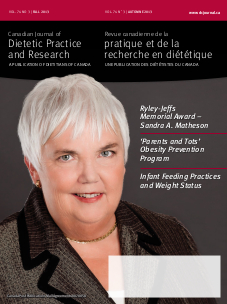Volume 74 • Number 3 • September 2013
Chair’s Message
Editor’s Message
Research
Purpose: Feeding practices for young Canadian children from economically disadvantaged neighbourhoods were examined to determine adherence to infant feeding recommendations and factors associated with children’s weight status. Methods: Data for the study were collected from 1996 to 2003 as part of Better Beginnings, Better Futures, a longitudinal primary prevention initiative in Ontario. Study subjects were 546 children at age three months and 483 children at age 48 months. Results: Mothers who had less than a high school education (odds ratio [OR] = 1.83, confidence interval [CI] = 1.01-3.29) and mothers who did not attend prenatal classes (OR=2.37, CI=1.33-4.24) were more likely to use formula. Mothers who were single parents were three times more likely to have an obese child (OR=3.35, CI=1.39-8.06) than were mothers who were married or with a partner. Conclusions: Targeted strategies are needed for families as single-parent households were predictive of obesity in young children. Innovative encouragement to participate in prenatal programming for pregnant women who have less than a high school education may improve breastfeeding rates.
Purpose: Fruit and vegetable (FV) consumption was examined among children aged seven to 10 years in a London, Ontario, neighbourhood. The goal was to determine areas requiring targeted programs to promote healthy lifestyles. Methods: Data were gathered from 136 students in grades 2 to 4. Each student attended one of four elementary schools within a neighbourhood designated a priority by the City of London Child and Youth Network. The Day in the Life Questionnaire was used to collect the data. Instances of FV consumption were compared with Eating Well with Canada’s Food Guide (CFG) guidelines. Results: Ninety-eight percent of participants did not follow the CFG-recommended minimum guidelines; they had fewer than five instances of FV consumption daily. Eighty-seven percent had fewer than two instances of FV consumption daily. Conclusions: These data support national findings of low FV consumption among children.
Objectif: L’objectif de cette étude est d’examiner les relations entre les pratiques alimentaires de la mère et l’alimentation de l’enfant d’âge préscolaire. Méthodes: Cent vingt-deux mères ont été recrutées par des milieux de garde de l’île de Montréal et ont rempli un questionnaire autoadministré. Celui-ci portait sur l’impact des pratiques alimentaires des parents sur l’alimentation de leur enfant, notamment sur les fréquences de consommation et les préférences alimentaires. Résultats: Des corrélations ont été observées entre les trois pratiques alimentaires maternelles, à savoir les restrictions, la pression à manger et les récompenses alimentaires, et le comportement alimentaire de l’enfant. En effet, ces trois pratiques ont été corrélées à des comportements alimentaires moins désirables chez l’enfant, comportements mesurés par des variations de fréquences de consommation et/ou de préférences alimentaires. Conclusions: Cette étude suggère que les pratiques alimentaires de la mère ont un effet direct sur l’acte alimentaire de l’enfant dans un contexte québécois. Ainsi, les mères doivent être informées quant à l’usage contre-productif de ces pratiques alimentaires et être outillées pour développer des stratégies alimentaires plus saines en remettant l’appétit de l’enfant et le plaisir de manger au coeur de leurs pratiques alimentaires.
Purpose: Measured resting metabolic rate (RMR) was compared with predicted RMR in a sample of young, non-obese women. Methods: In 52 women aged 19 to 30 with a body mass index of 16 to 29 kg/m2, RMR was measured with a MedGem indirect calorimeter and predicted with five commonly used equations: the Harris-Benedict (1919), Mifflin (1989), Owen (1985), Schofield weight (1985), and Schofield weight and height (1985) equations. Measured RMR and predicted RMR were compared through the use of various measures. Results: In comparison with the measured RMR, the RMR predicted with four of the five equations was significantly higher (by 16 to 225 kcal/day, p<0.001). At the group level, the Owen equation performed best and captured the greatest proportion of individuals (65%) for whom predicted RMR differed from measured RMR by less than 10%. With the other four equations, residuals exceeded 10% for more than two-thirds of participants. For the Harris-Benedict, Mifflin, and Owen equations, every 100 kcal/day increase in measured RMR was associated with a 6% to 8% decrease in error. The optimal prediction range (within 10% of the measured RMR) was different for each: Owen equation 1105 to 1400 kcal/day, Mifflin equation 1280 to 1595 kcal/day, and Harris-Benedict equation 1345 to 1630 kcal/day. Conclusions: Prediction equations should be modified according to the amount of corresponding percentage error. Where possible, RMR should be measured. Barring this, the Owen equation should be used for young, non-obese women.
Perspectives in Practice
While demand for long-term care (LTC) in Canada is expected to grow in the coming years, little is known about the current LTC dietetic workforce or its members’ practice-related concerns. A web-based survey was developed and distributed to and subsequently completed by 75 LTC dietitians in British Columbia. The survey was intended to characterize dietitians’ demographic characteristics, educational and employment experiences, salaries and benefits, future employment plans, and concerns about current practice. Regression models were used to examine the associations between demographic, educational, and employment characteristics and self-reported hourly wages. The majority of respondents were employed at more than one facility (57%) and did not belong to a union (71%). The mean hourly wage for LTC dietetics positions was $37.50 ± $5.85, and was significantly higher for positions that did not provide additional employee benefits (p<0.05). Hourly wages were not significantly higher for dietitians with more years of experience or graduate-level education. Concerns were raised about potential implications of revised residential care regulations for workload, and only 36% of respondents reported being committed to working in the area of LTC dietetics in the future. This study highlights practice-related challenges and future opportunities to build the LTC dietetic workforce, and can inform planning for training, recruitment, and retention.
Dietary patterns were examined in a convenience sample of 36 female University of Alberta students, all of whom had completed at least one nutrition course. Data from a validated food frequency questionnaire were used to determine if students had a dietary pattern similar to that recommended in Eating Well with Canada's Food Guide (EWCFG) or by the Traditional Healthy Mediterranean Diet Pyramid (THMDP), as measured using a Mediterranean Diet Quality Index Score. No student consumed the THMDP minimum number of portions of legumes, seeds, and nuts, of olive oil, or of whole grains. The majority did not meet the minimum EWCFG recommendations for any food group. The results suggest that nutrition education alone may be insufficient to ensure optimal dietary patterns among female university students. The methodology reported in this study is novel in assessing whether dietary patterns resemble the THMDP or the EWCFG.
Report
Purpose: Engaging parents in interventions can be difficult because of various barriers. An engaging children’s program that runs parallel to a parent program may facilitate parent participation. In this study, we assessed parents’ perception of the children’s component of Parents and Tots Together (PTT), a family-based obesity prevention program. Methods: Fifteen of the 16 ethnically diverse parents who participated in an uncontrolled trial of PTT completed a survey assessing their satisfaction with the PTT children’s component. More detailed information was obtained from one-on-one qualitative interviews with seven parents. Results: Attendance at program sessions was relatively high; 69% of parents attended six or more of the nine sessions. Survey data revealed that 87% of parents were “very satisfied” with the children’s group. Approximately 73% of parents reported that the program was “very useful” in helping their child learn the importance of healthy eating and physical activity. In qualitative interviews, many parents identified the children’s program as a motivator for attendance at the program sessions. Conclusions: The interactive children’s program was well received by parents and may serve as a catalyst for parent participation. Larger, randomized trials are needed to determine the effectiveness of children’s programming for enhancing parent participation.
Recognition
OPEN ACCESS
Now as never before, familiar challenges require bold, novel approaches. Registered dietitians will benefit by cultivating an entrepreneurial mindset that involves being comfortable with uncertainty, learning to take calculated risks, and daring to just try it. An entrepreneur is someone who takes risks to create something new, usually in business. But the entrepreneurial mindset is available to anyone prepared to rely only on their own abilities for their economic security and expect no opportunity without first creating value for others.
Canadian Foundation for Dietetic Research
OPEN ACCESS
From the west coast of Canada it is with great pleasure that I welcome you to beautiful Victoria, host city of the 2013 Dietitians of Canada Annual Conference Research Event. This year the Canadian Foundation for Dietetic Research received many high quality abstracts that clearly illustrate diverse interests and issues faced by members in everyday dietetic practice. Through the continued support of Dietitians of Canada and Canadian Foundation for Dietetic Research, the 2013 Research Event has shaped up to be an inspiring forum for strengthening the practice of Canadian dietitians from coast to coast to coast. The topics showcased in this year’s abstracts span a broad scope of practice areas that include Public Health Nutrition, Undergraduate Education and Dietetic Internship, Patient Services, and using Technology in Health Education, to name a few. Moreover, the findings help us to better understand the effects of ethnicity, socioeconomic, gender, and age on health and illness. New to this year’s event, each presenter will provide a 10-minute oral presentation followed by a short question period. This lively format replaces the electronic posters and 20-minute presentations used in the past and is sure to ignite plenty of enthusiastic discussion! As you listen to and reflect on the issues that your colleagues passionately share, I urge you to consider how you can become more involved in the research and experience-sharing process. Discuss an idea with a presenter you would like to meet or with colleagues you already know. By engaging our curious minds in critical dialogue, together we will continue to strengthen dietetic knowledge and practice in Canada. A successful Research Event requires dedicated work and commitment from many people. On behalf of Dietitians of Canada and Canadian Foundation for Dietetic Research, I would like to extend a special thank you to the members of the 2013 Abstracts Review Committee who represented community nutrition, private practice, clinical nutrition, food service, and academic areas of expertise and practice and worked collaboratively to ensure an outstanding line-up of research: Colleen McGuire (atthetablenutrition.com), Dani Shahvarani-Renouf (4elementshealth. wordpress.com), Dr. Evelyn Cornelissen (Research, Southern Medical Program, Faculty of Medicine, University of British Columbia), Gerry Kasten (Community Nutritionist, Squamish Community Health Centre, Vancouver Coastal Health), Mahsa Jessri (PhD Candidate, Faculty of Medicine, University of Toronto), and Mohsen Saberi (Food Services Manager, University of British Columbia Hospital). I would also like to express my gratitude to Dr. Daphne Lordly (Associate Professor, Mount St. Vincent University), Dr. Karen Davison (Instructor, Langara College), and Theresa Cividin (Practice Leader, Clinical Nutrition, Vancouver Coastal Health) for graciously moderating research sessions. And finally, a special thank you to Diana Sheh at Dietitians of Canada and Isla Horvath at Canadian Foundation for Dietetic Research for guiding the Committee through the inaugural use of an online abstract review system and in scheduling the research presentations. I look forward to seeing you at the Research Event on June 14th to celebrate an impressive selection of dietetic research that is happening in Canada from resplendent coast to coast to coast.










